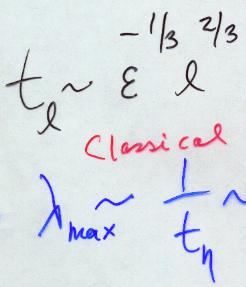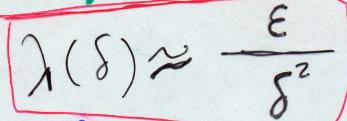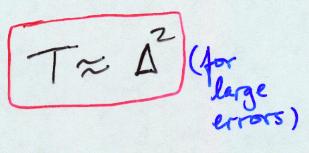FSLE and Turbulence:
Eddy turnover time:
![]()
Kolmogorov Scale: ![]() , where Re is
the Reynolds Number.
, where Re is
the Reynolds Number.
The Kolmogorov theory tells us that this must be scale independent:**


Therefore, predictability time goes to infinity when Re goes to infinity (fully-developed turbulence). At least on scales that are bigger than the smallest and slower than the fastest (i.e. "real life"), this shows the problem with the classical (Kolmogorov) theory. WE CAN, TO SOME EXTENT, PREDICT THE ONSET OF TURBULENCE.
The turbulent FSLE:
 ,
where the numerator is the average energy transfer rate and the denominator
is the square of the FINITE error. To a first approximation, this is not affected
by intermittency; however, a more accurate version can be obtained by taking
into account intermittency corrections.
,
where the numerator is the average energy transfer rate and the denominator
is the square of the FINITE error. To a first approximation, this is not affected
by intermittency; however, a more accurate version can be obtained by taking
into account intermittency corrections.
Plugging this in to the finite-scale version of T gives:

Note: Cannot check this with CFD because of the limited inertial range achievable with today's computers. Rather, simplied models called "shell models" are used. One such model is the GOY model: this is a Komolgorov-like energy cascade with chaotic dynamics.
Algortihm:
1) Integrate two realizations of the same system with very close initial conditions.
2) Compute doubling times Tr.
3)Obtain ensemble average of many experiments—>gives FSLE.
The results are shown on the next page. Please proceed to see a wonderful result!
-------------------------
**We now know that fully developed turbulence is not completely self-similar [6 (p. 144)]. This must account for some of the deviation from Kolmogorov theory that is seen in the laboratory.
![]()